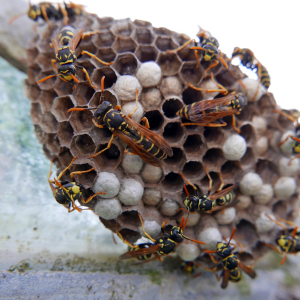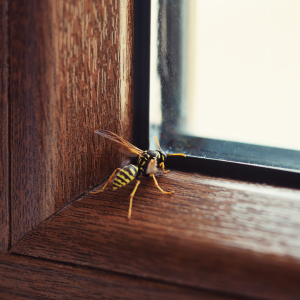


As the temperatures begin to drop in St. Louis, stinging insects like wasps are on the hunt for warm shelter. Unfortunately, your home might seem like the perfect retreat for these unwanted guests. Fall is the prime time for wasps to seek out cozy hiding spots, and common entry points like fireplaces, vents, and basement windows provide easy access.
In this post, we’ll explore how wasps find their way into your home and what you can do to prevent them from becoming your unwelcome housemates this fall.
How Do Wasps Get Inside?
Wasps are more likely to enter homes during the fall because they’re trying to escape the colder temperatures outside. They are often drawn to warmer spaces, and unfortunately, your home is full of potential entry points, especially in areas where cracks or gaps might not be immediately visible. Common access points include:
- Fireplaces: Chimneys are often left uncovered, providing wasps with a direct route into your living room.
- Vents: Dryer vents, bathroom vents, and other openings can be appealing to stinging insects looking for warmth.
- Basement Windows: Older or improperly sealed basement windows can easily become entryways for wasps and other insects.
Why Are Wasps Entering in the Fall?
Wasps and other stinging insects don’t typically survive through the winter, but in their search for a warmer environment, they may find their way into attics, basements, or wall voids. If left unchecked, these insects can become a nuisance, and some species can be aggressive if disturbed.
What Can You Do to Prevent Wasp Infestations?
Preventing wasps from entering your home is all about sealing potential access points. Here are a few simple steps you can take to protect your home:
- Install chimney caps to block wasps from entering through your fireplace.
- Seal cracks around doors, windows, and vents with caulking or weather stripping.
- Cover vents with fine mesh screens to stop wasps from squeezing through.
- Inspect basement windows for any gaps or damage and replace them if needed.
- Remove food sources like uncovered garbage or fallen fruit from your yard, which can attract wasps.
Frequently Asked Questions About Fall Wasp Invasions
1. Why are wasps more aggressive in the fall?
As their food supply dwindles in the fall, wasps become more desperate and aggressive. They are also protecting their nests and queen, making them more likely to sting when disturbed.
2. How do I know if wasps are nesting inside my home?
You might hear a buzzing sound from your walls or attic, or you may notice more wasps flying in and out of specific areas like vents or cracks near windows.
3. Are wasps dangerous to have inside my home?
Yes, wasps can be dangerous. They sting when threatened, and for individuals who are allergic, a sting can lead to serious medical issues. Even without allergies, multiple stings can be painful and cause swelling.
4. Can wasps enter through small cracks?
Yes, wasps can squeeze through small cracks or gaps in windows, vents, or around doors. Even the tiniest opening can be an invitation for them to come inside.
5. What should I do if I find a wasp nest in my home?
If you discover a wasp nest, do not attempt to remove it yourself. Wasps can become aggressive if they feel threatened. Instead, contact a pest control professional to handle the situation safely.
Why Call STL Pest Control for Service?
At STL Pest Control, we understand how frustrating and concerning it can be to find wasps inside your home, especially as the weather cools down. Our experienced team of pest control professionals knows exactly where to look and how to safely remove wasps and other stinging insects from your property. We use effective, targeted solutions to eliminate wasps and prevent them from returning.
When you call STL Pest Control, you’re not just getting a quick fix—you’re getting peace of mind. We’ll assess your home for potential entry points and provide long-term strategies to keep your home safe from wasps and other pests. Don’t let wasps make your home theirs this fall. Contact STL Pest Control today for a consultation.

